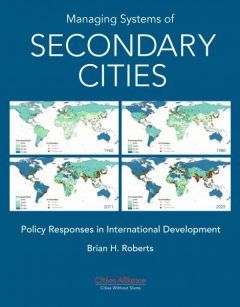Managing Systems of Secondary Cities: Policy Responses in International Development

Managing Systems of Secondary Cities is a path-breaking and original report on the relevant role secondary cities – particularly those in low- and middle-income countries – have and will have as the world completes its urban transition.
Intended to bring to the fore the knowledge, policy and funding gaps on secondary cities vis-à-vis mega- and primary cities, the book builds on the renewed interest in secondary cities of governments, international development agencies and scholars in more recent years. With almost 70 per cent of the world’s population expected to live in urban centres by the middle of this century, and with more than 40 per cent living in secondary cities – some of these among the fastest-growing cities in the world – this book has relevance for city leaders, urban planners, international development practitioners, and all those concerned with urban issues in general.
Brian Roberts suggests a systems approach for the re-conceptualization of secondary cities – secondary cities are no longer defined exclusively by population size but rather in terms of their functionality and connectivity with broader global and national systems of cities. Grounded in a political economy perspective, the report is framed around the concept of New Economic Geography (NEG). “How can NEG benefit cities in poorer regions and countries?” “How can a city align itself in a new global, and more competitive, system of trade and development?” These are some of the central questions underlying the new management and development approach secondary cities might need to unleash their latent development potential and become more competitive.
This book is the result of a background study on systems of secondary cities commissioned by Cities Alliance. Acknowledging the lack of a one-size-fits-all type of secondary city policy, a spectrum of policy responses and evidence-based recommendations for the management and development of urban systems are derived from 15 case studies across five geographic regions – Asia, Latin America, Pacific, Middle East and North Africa, and sub-Saharan Africa.
A key contribution of the book is the examination of the role of international development assistance agencies and organizations in supporting the development of systems of secondary cities. Whereas the role of intermediary cities has been a blind spot in the field of international development, a framework for re-orienting international aid towards secondary cities as a catalyst to unlock the development potential of sub-national regions is delineated.
The cross-cutting theme of the book is the understanding of secondary cities as intermediary nodes in the system of cities – connecting, linking and allowing flows. As such, collaborative – rather than competitive – advantage should be the focus of secondary city development to overcome economies of scope and scale enjoyed by large metropolitan-region cities. Innovative and collaborative governance arrangements for the planning and management of secondary cities – e.g. metropolitan and trans-government governance – as well as collaborative approaches regarding co-finance – e.g. co-investment of capital by central government, international development agencies and business in partnerships – might delineate the way forward.
Copies of this book can be downloaded from http://www.citiesalliance.org/node/4978.
For those interested in this topic, you can download the book Small and Intermediate Urban Centres, Their Role in Regional and National Development within the Third World that IIED prepared and Hodder and Stoughton published in 1986: http://pubs.iied.org/7019IIED.html.
Also of interest may be an annotated bibliography published in 1988 (http://pubs.iied.org/pdfs/7013IIED.pdf) and a working paper in 2006 called Outside the Large Cities: The demographic importance of small urban centres and large villages in Africa, Asia and Latin America (http://pubs.iied.org/10537IIED.html).
Book note prepared by María Evangelina Filippi
Search the Book notes database
Our Book notes database contains details and summaries of all the publications included in Book notes since 1993 - with details on how to obtain/download.
Use the search form above, or visit the Book notes landing page for more options and latest content.
For a searchable database for papers in Environment and Urbanization, go to http://eau.sagepub.com/

